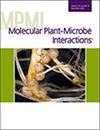求助PDF
{"title":"A Genome-Wide Association Study Identifies Markers and Candidate Genes Affecting Tolerance to the Wheat Pathogen <i>Zymoseptoria tritici</i>.","authors":"Alexey Mikaberidze, Bruce A McDonald, Lukas Kronenberg","doi":"10.1094/MPMI-08-24-0085-FI","DOIUrl":null,"url":null,"abstract":"<p><p>Plants defend themselves against pathogens using either resistance, measured as the host's ability to limit pathogen multiplication, or tolerance, measured as the host's ability to reduce the negative effects of infection. Tolerance is a promising trait for crop breeding, but its genetic basis has rarely been studied and remains poorly understood. Here, we reveal the genetic basis of leaf tolerance to the fungal pathogen <i>Zymoseptoria tritici</i> that causes the globally important septoria tritici blotch (STB) disease on wheat. Leaf tolerance to <i>Z. tritici</i> is a quantitative trait that was recently discovered in wheat by using automated image analyses that quantified the symptomatic leaf area and counted the number of pycnidia found on the same leaf. A genome-wide association study identified four chromosome intervals associated with tolerance and a separate chromosome interval associated with resistance. Within these intervals, we identified candidate genes, including wall-associated kinases similar to <i>Stb6</i>, the first cloned STB resistance gene. Our analysis revealed a strong negative genetic correlation between tolerance and resistance to STB, indicative of a trade-off. Such a trade-off between tolerance and resistance would hinder breeding simultaneously for both traits, but our findings suggest a way forward using marker-assisted breeding. We expect that the methods described here can be used to characterize tolerance to other fungal diseases that produce visible fruiting bodies, such as speckled leaf blotch on barley, potentially unveiling conserved tolerance mechanisms shared among plant species. [Formula: see text] Copyright © 2025 The Author(s). This is an open access article distributed under the CC BY 4.0 International license.</p>","PeriodicalId":19009,"journal":{"name":"Molecular Plant-microbe Interactions","volume":" ","pages":"265-274"},"PeriodicalIF":3.4000,"publicationDate":"2025-03-01","publicationTypes":"Journal Article","fieldsOfStudy":null,"isOpenAccess":false,"openAccessPdf":"","citationCount":"0","resultStr":null,"platform":"Semanticscholar","paperid":null,"PeriodicalName":"Molecular Plant-microbe Interactions","FirstCategoryId":"99","ListUrlMain":"https://doi.org/10.1094/MPMI-08-24-0085-FI","RegionNum":3,"RegionCategory":"生物学","ArticlePicture":[],"TitleCN":null,"AbstractTextCN":null,"PMCID":null,"EPubDate":"2025/4/2 0:00:00","PubModel":"Epub","JCR":"Q2","JCRName":"BIOCHEMISTRY & MOLECULAR BIOLOGY","Score":null,"Total":0}
引用次数: 0
引用
批量引用
Abstract
Plants defend themselves against pathogens using either resistance, measured as the host's ability to limit pathogen multiplication, or tolerance, measured as the host's ability to reduce the negative effects of infection. Tolerance is a promising trait for crop breeding, but its genetic basis has rarely been studied and remains poorly understood. Here, we reveal the genetic basis of leaf tolerance to the fungal pathogen Zymoseptoria tritici that causes the globally important septoria tritici blotch (STB) disease on wheat. Leaf tolerance to Z. tritici is a quantitative trait that was recently discovered in wheat by using automated image analyses that quantified the symptomatic leaf area and counted the number of pycnidia found on the same leaf. A genome-wide association study identified four chromosome intervals associated with tolerance and a separate chromosome interval associated with resistance. Within these intervals, we identified candidate genes, including wall-associated kinases similar to Stb6 , the first cloned STB resistance gene. Our analysis revealed a strong negative genetic correlation between tolerance and resistance to STB, indicative of a trade-off. Such a trade-off between tolerance and resistance would hinder breeding simultaneously for both traits, but our findings suggest a way forward using marker-assisted breeding. We expect that the methods described here can be used to characterize tolerance to other fungal diseases that produce visible fruiting bodies, such as speckled leaf blotch on barley, potentially unveiling conserved tolerance mechanisms shared among plant species. [Formula: see text] Copyright © 2025 The Author(s). This is an open access article distributed under the CC BY 4.0 International license.
一项全基因组关联研究鉴定了影响小麦病原菌酵母病耐受性的标记和候选基因。
植物保护自己免受病原体的侵害,要么使用抗性,以宿主限制病原体繁殖的能力来衡量,要么使用耐受性,以宿主减少感染负面影响的能力来衡量。耐受性是一种很有前途的作物育种性状,但其遗传基础很少被研究,而且仍然知之甚少。在此,我们揭示了小麦叶片对引起全球重要的小麦黑斑病的真菌病原菌酵母(Zymoseptoria tritici)抗性的遗传基础。小麦叶片对小麦偃麦草枯病菌的耐受性是近年来在小麦中发现的一种数量性状,该性状采用自动图像分析方法对小麦的症状叶面积进行了定量分析,并对同一片叶片上发现的穗状芽孢杆菌数量进行了统计。一项全基因组关联研究确定了与耐受性相关的四个染色体间隔和与抗性相关的一个单独的染色体间隔。在这些时间间隔内,我们确定了候选基因,包括类似于Stb6的壁相关激酶,这是第一个克隆的STB抗性基因。我们的分析显示,对STB的耐受性和抗性之间存在很强的负相关遗传关系,表明存在权衡关系。耐受性和抗性之间的权衡会阻碍这两种性状的同时繁殖,但我们的研究结果表明,使用标记辅助育种是一种可行的方法。我们期望这里描述的方法可以用来表征对产生可见子实体的其他真菌疾病的耐受性,例如大麦的斑点斑病,潜在地揭示植物物种之间共有的保守耐受性机制。
本文章由计算机程序翻译,如有差异,请以英文原文为准。

 求助内容:
求助内容: 应助结果提醒方式:
应助结果提醒方式:


